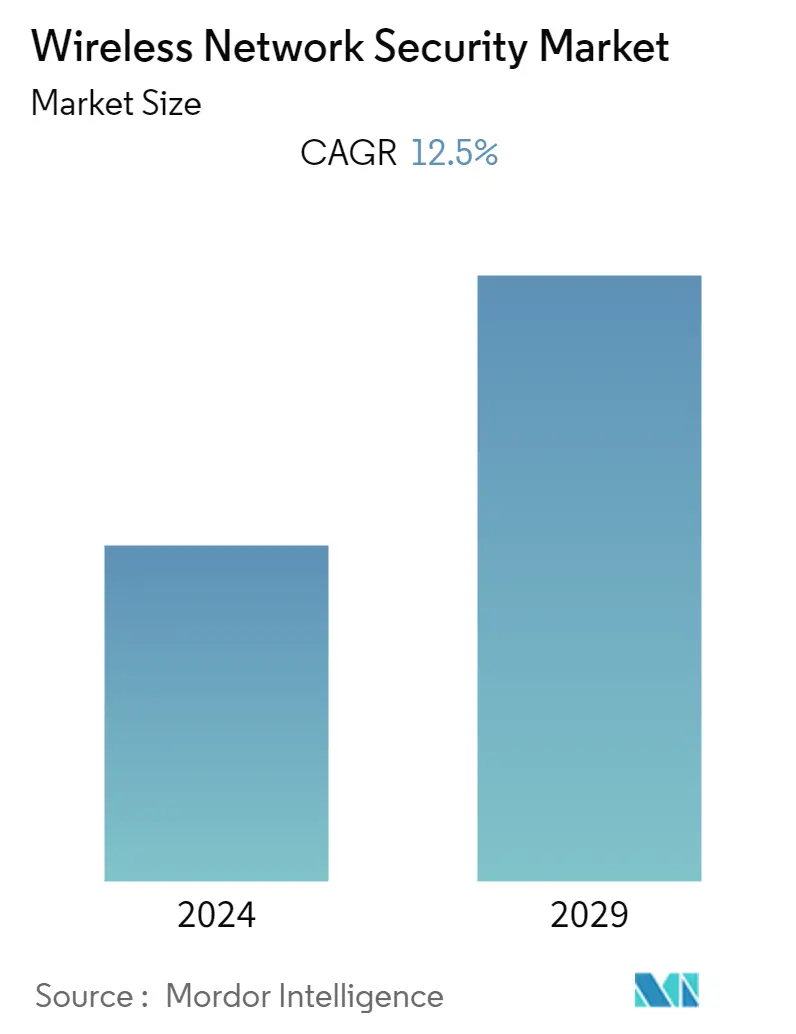Market Size of Wireless Network Security Industry

| Study Period | 2019 - 2029 |
| Base Year For Estimation | 2023 |
| CAGR | 12.50 % |
| Fastest Growing Market | Asia Pacific |
| Largest Market | North America |
| Market Concentration | Low |
Major Players
*Disclaimer: Major Players sorted in no particular order |
Need a report that reflects how COVID-19 has impacted this market and its growth?
Wireless Network Security Market Analysis
The wireless network security market is expected to register a CAGR of over 12.5% over the forecast period. The increasing consumer propensity toward adopting wireless devices in residential and commercial spaces is augmenting the wireless network security demand.
- The growing number of enterprises opting for digital networks and mobile devices is further influencing the market. According to a report from the Wireless Broadband Alliance (WBA), more than a third (33%) of service providers, technology vendors, and enterprises already have plans to deploy Wi-Fi 7 by the end of last year. Moreover, the report also revealed that Wi-Fi 6E had become the de facto industry standard, with 53% having already deployed the technology and a further 44% working on plans to adopt Wi-Fi 6E in the next 12-18 months. Such developments are expected to influence enterprises to enhance their security as well.
- The global adoption of Wi-Fi is on the rise in both commercial and residential space, with a growing number of mobile devices that are connected to high-speed internet is on the rise. According to Cisco, the Wi-Fi hotspots are expected to grow to 628 million public Wi-Fi hotspots by this year from 169 million in 2018. The growing adoption of IoT augments growth. With the change in the number of Wi-Fi hotspots, security risks are increasing, and these enterprises are moving toward adopting robust encryption. WEP uses an old encryption method and holds prominence in old systems, whereas WPA is one of the widely used standards among network devices.
- WEP and TKIP protocols were deemed insecure many years ago. Wi-Fi connections carried out via these protocols can be decrypted relatively quickly, and various hardware vendors are increasingly avoiding these protocol usage. Starting with May 2019, Windows 10 warned its users if they attempted to connect to a Wi-Fi network that uses these protocols. Apart from this, WPA-enabled devices are prone to attacks. For instance, a new bug present on the chips made by Broadcom and Cypress rendered about one billion devices vulnerable to an attack that can decrypt information in transit, and the bug is called 'Kr00k'. Using the flaw, attackers can exfiltrate information by intercepting and decrypting packets sent over the WPA2 network.
- Devices, such as Amazon Echo, Kindle, iPhone, iPad, MacBook, Google Nexus, Samsung Galaxy, Raspberry Pi 3, Xiaomi, and some Asus and Huawei products, tested positive for Kr00k vulnerability. Due to such developments, the wireless security demand is expected to become vital, especially in network-handling mission-critical workloads. With the increasing deployment of IoT and BYOD trends, the need for wireless network security is expected to be one of the enterprises' priorities. According to a study by Outpost24, 61% of security experts mentioned that BYOD offers a severe threat to their organization, and 21% feared attacks via office-based IoT devices, such as printers. The greatest wireless attack threats were password theft at 62% and Botnet/Malware threats at 60%.
- Further, emerging economies plan to boost connectivity to contribute to the market growth rate. For instance, Brazil announced plans to increase public Wi-Fi availability. According to the technical cooperation agreements signed by the Banco do Brasil Foundation and the Brazilian Micro and Small Business Support Service (SEBRAE) with the Ministry of Communications, approximately 500 new Wi-Fi hotspots will be put in place by last year, benefiting 1,000 locations nationwide. The growing adoption of IoT augments growth. With the change in the number of Wi-Fi hotspots, security risks are increasing, and these enterprises are moving toward adopting robust encryption.
- The CISA (Cybersecurity and Infrastructure Security Agency), which is a part of the Department of Homeland Security, warned of COVID-19 network-security issues, with the most common including phishing, malware distribution, registration of new domain names containing wording related to coronavirus or COVID-19 and attacks against newly and often rapidly deployed remote-access and teleworking infrastructure. In April 2020, CISA released new guidance on how remote government workers and potentially others should address network security. It included interim Trusted Internet Connections (TIC) 3.0 advice to aid agencies in securing their network and cloud environments.
